My Siena Palio Experience Part One
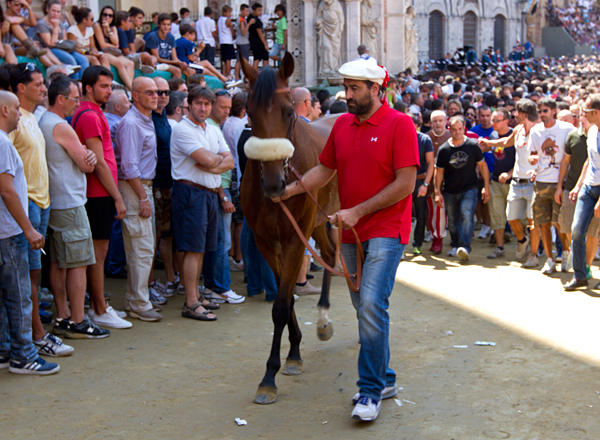
Attending the Palio in Siena was always a goal of mine, and in fact it was certainly on my “bucket list” of things I wanted to participate in while here in Italy over the next couple of years. I’ve watched the race many times on television, and for the average person (like myself) watching this bareback race that lasts less than two minutes, you might be tempted to ask what the fuss is about. After experiencing the Palio first hand, I must say that I certainly feel differently about it now.
The opportunity to attend the Palio this past August fell into our laps when Dario Castagno posted on FaceBook months ago that he had tickets for one more couple to attend the Palio as well as the Palio festivities with him as a guide. We’ve read every book Dario has written (Too Much Tuscan Sun & Too Much Tuscan Wine to name just two of his many!), and though we’ve briefly corresponded with him in the past, we’ve never had the chance to meet him in person. We thought this would be a great opportunity for us to have an amazing experience in Siena, as not only would we finally get to attend a Palio, we would also get to meet Dario and would benefit from his vast knowledge of this historical event throughout the week’s events that lead up to the race.
For those unfamiliar with the Palio, it is a horse race that is held twice each year, on July 2 and August 16, in Siena, Italy. Ten horses and bareback riders participate, representing ten of the seventeen contrade. A contrada is simply a city district or ward (think neighborhood). The Palio held on July 2 is named Palio di Provenzano, in honor of the Madonna of Provenzano, who has a church in Siena. The Palio held on August 16 is named Palio dell’Assunta, in honor of the Assumption of Mary. We were told that they are two completely separate races, despite the fact they must follow the same strict guidelines. Every Palio has ten contrade participating, so not all seventeen contrade can take part in the Palio at any one time. The seven contrade that did not take part in that month of the previous year are automatically included, and three more are chosen by lottery as wild card picks to participate, bringing the total to ten.
A very colorful and majestic pageant or parade, the Corteo Storico, precedes every race and can last up to two hours. Each of the seventeen contrade participates in the parade, even the ones not racing in that particular Palio, although only the contrade racing that day are judged. The race itself involves three laps around the magnificent Piazza del Campo, on which a thick layer of dirt has been laid, and the race usually lasts no more than ninety seconds. It is not uncommon for a few of the jockeys to be thrown off their horses while making the treacherous turns, and the winning horse in fact may be one that crosses the finish line without a jockey.
The Palio has evolved through the centuries until the rules of the modern Palio were established in 1721, during the reign of Violante Beatrice of Bavaria, the governor of Siena. Unlike many of the medieval historical festivals in Italy, the Palio is real life and not a reenactment, and it was impossible for us not to feel the passion and emotion that surrounded the city of Siena during the week of the Palio this past August.
About a week before each Palio, dirt is carefully placed around the circumference of the Campo to create the track. This is not just everyday dirt, as it is the same dirt used for each race that has been recycled, reground and refurbished, and it is carefully stored during off-season for upcoming races. Days before the Palio, bleacher seats or palchi are set up around the Campo complete with numbered seats. Sales of the seating are controlled by the owners of the establishments directly behind the bleacher seats, and priority is often given to returning clients. Though one can stand in the center of the Campo for free, seats on these grandstands allow everyone to have a great view of both the pageant and race although they are quite expensive. We were fortunate enough to have seats midway up and just past the finish line so the horses all finished the race right in front of us.
When planning our first Palio adventure, we were unsure as to what events we absolutely should not miss, and after speaking with Dario, we decided that we would attend the drawing of the horses on the Tuesday, and then return to Siena Thursday and Friday as both those days are packed with Palio events we knew we wanted to attend. We drove to Siena on Tuesday morning and met Dario in the contrada of the caterpillar officially known as The Noble Contrada of Bruco, along with the other couple from Alabama that were attending the week’s activities with us. I hadn’t warned Dario ahead of time, but I brought along my 5 pound Yorkie named Luca and although I was concerned over Dario’s reaction, he didn’t blink an eye and although he may have been cringing inside, he was kind enough to allow Luca to attend all the week’s activities. I am very happy to say Luca was a trooper as usual and did not make a peep the entire week. Dario is a member of the caterpillar contrada and since they were not racing in the August Palio we were lucky that he had much more free time on his hands than he would of if they had been racing.
After meeting up with Dario, he took us on a tour of the headquarters of the Bruco, and we were all amazed at the spacious and lovely headquarters this contrada was fortunate to have. We then toured the Bruco museum and were actually able to touch the historical costumes worn during the pageant preceding the Palio, and to view all the Palio banners won by the Bruco throughout the years. Dario is extremely knowledgable about the history of the Palio, particularly as it involves the Bruco, and we were all fascinated learning about the traditions and history of the Palio throughout the ages. Each of the seventeen contrade all have their own headquarters and museums as well as their own private chapels. I was fascinated to learn that belonging to a contrada was truly a way of life, and not simply a group one joined, and that for the Sienese, their contrada was their family.
After our tour of the Bruco headquarters we headed over to the Campo to watch the drawing of the horses, or La Tratta. This is an extremely important event as each of the ten participating contrade are assigned by lottery one of the ten chosen horses. Once the horse has been assigned to the contrada, they will then begin their search for the right jockey to hopefully bring them a win. This is a very emotional event as each contrada has a particular horses they are hoping for, and the ones that are happy about their assigned horses are extremely jubilant with much cheering and chanting. Those not so happy quietly accept their horse and lead it back to their contrada to begin the search and negotiations for the best jockey they can find. When the horses reach their stables in the contrada, they receive twenty four hour attention from the groom, a veterinarian, and a blacksmith, and the horses are closely watched over to prevent any underhanded activity such as doping by one of their enemies. Once the horses are assigned, there is in fact no substitution, and if for whatever reason, such as illness or injury, the horse is unable to run, the contrada will have to forfeit, and then be excluded from racing in that Palio.
It takes days to narrow the selection down to the ten horses that will race in each Palio, and months before the Palio is to take place, private horse breeders offer the pick of their stables hoping their horses will be chosen, and the horses must all be of mixed breed, as no purebred horses are allowed. Three days before the race, horses are narrowed down from the over 100 that are offered for selection to just thirty horses that participate in trial races the day of the drawing. The main representatives of the participating contrade, the Capitani, then choose ten horses from these thirty, of approximately equal quality and each are carefully examined by veternarians. The ten horses are then assigned by lottery to each of the participating contrade and the search for a jockey begins. Interesting enough, the majority of the jockeys are not Sienese, many in fact are Sardinians. The jockeys are not loyal to any specific contrada, and a winning jockey is often riding for another contrada during the subsequent Palio. The jockeys are motivated by money first, and a winning jockey can make a very good living this way. As one would expect, there is a lot of behind the scenes subterfuge, and in fact a jockey can be lured from one contrada to another as late as the day of the Palio.
Our first day in Siena was a full one and Dario really gave us a good feel for how important the Palio truly is to the Sienese people. These are not races put on as a show for tourists, but a part of daily life imbedded into the history of Siena that is embraced as passionately today as it was centuries ago. We left Siena after the drawing of the horses or La Tratta looking forward to the rest of the activities that revolve around the Palio later that week, and I couldn’t help thinking that if I didn’t love Umbria quite so much, I think I could be very happy being Sienese!
See My Siena Palio Experience Part Two!
The 17 Contrade of Siena
The Noble Contrada of Aquila – Eagle
Allies – Civetta, Drago
Enemy – Pantera
The Contrada of Chiocciola – Snail
Allies – Istrice, Pantera, Selva
Enemy – Tartuca
The Captain Contrada of Onda – Wave
Allies – Nicchio, Tartucca, Valdimontone
Enemy – Torre
The Contrada of Pantera – Panther
Allies – Chiocciola. Civetta, Giraffa, Leocorno
Enemy – Aquila
The Contrada of Selva – Forest
Allies – Chiocciola, Tartuca
Enemy – None
The Contrada of Tartuca – Turtle
Allies – Leocorno, Onda, Nicchio, Selva
Enemy – Chiocciola
The Contrada Priora of Civetta – Owl
Allies – Aquila, Istrice, Giraffa, & Pantera
Enemy – Leocorno
The Contrada of Leocorno – Unicorn
Allies – Bruco, Pantera, Tartuca
Enemy – Civetta
The Noble Contrada of Nichio – Shell
Allies – Bruco, Onda, Tartuca
Enemy – Valdimontone
The Contrada of Torre – Tower
Allies – Bruco
Enemy – Oca
The Contrada of Valdimontone – Ram (August 2012 Palio Winners)
Allies – Onda
Enemy – Nicchio
The Noble Contrada of Bruco
Allies – Istrice, Nicchio, Torre
Enemy – None
The Contrada of Drago – Dragon
Allies – Aquila
Enemy – None
The Imperial Contrada of Giraffa – Giraffe
Allies – Civetta, Istrice, Pantera
Enemy – None
The Sovereign Contrada of Istrice – Porcupine
Allies – Bruco, Chiocciola. Civetta. Giraffa
Enemy – Lupa
The Contrada of Lupa – She Wolf
Allies – None
Enemy – Istrice
The Noble Contrada of Oca
Allies – None
Enemy – Torre
Books by Dario Castagno
Great Book On Siena & The Palio – Seven Seasons in Siena
Article Sources –
A Guide to the Palio – Betti Editrice 2008
The Palio of Siena Through The Centuries – Text by Serena Bindi 2002 Edimond srl
Palio The Race Of The Soul – Mauro Civai, Enrico Toti 2002
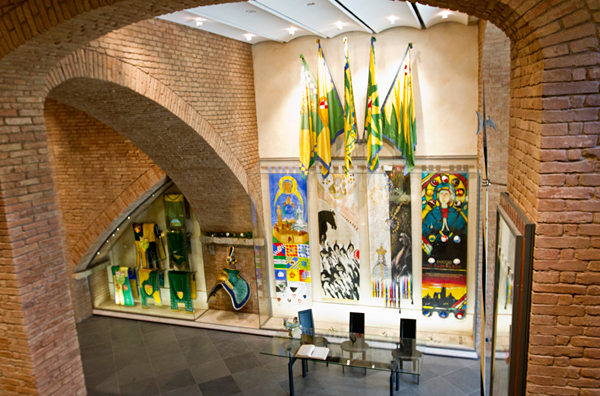
The Amazing Museum of The Noble Contrada of Bruco Showing The Winning Palio Banners Of Recent Years
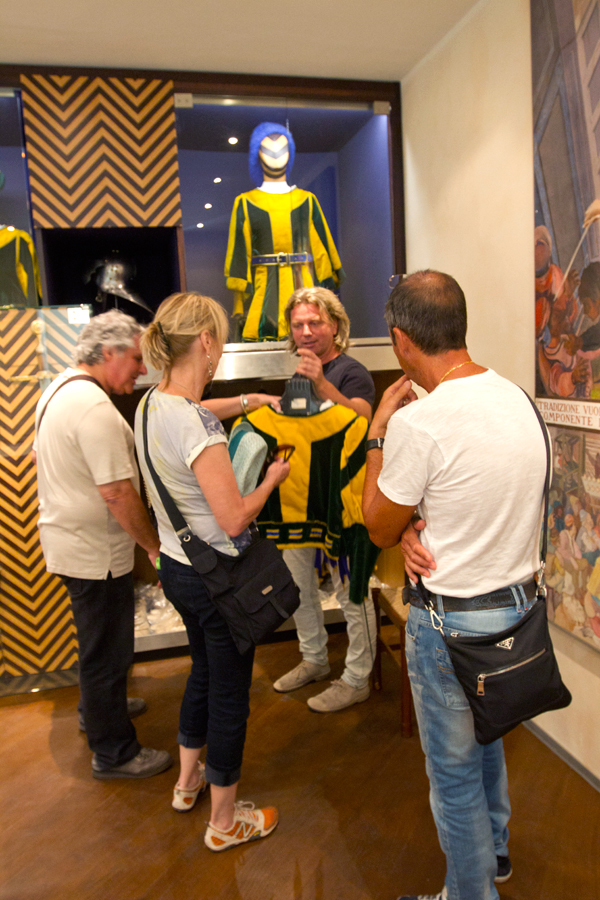
Dario Castagno Letting Us Check Out The Historical Costumes Worn by The Bruco Each Palio
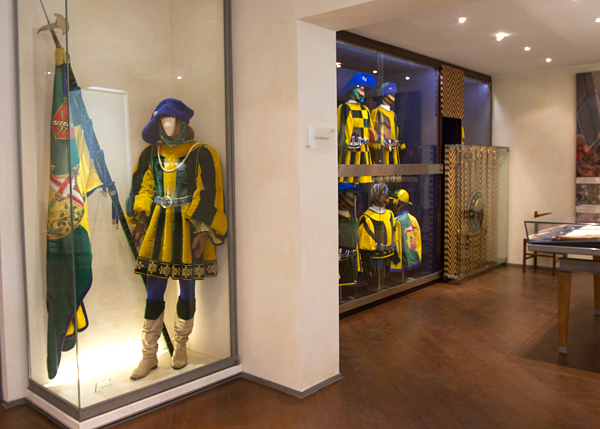
More Medieval Costumes Of The Noble Contrada of Bruco

The Chapel Within The Bruco Headquarters – Horse Are Taken Into The Contrada Chapels Before Each Palio For A Blessing
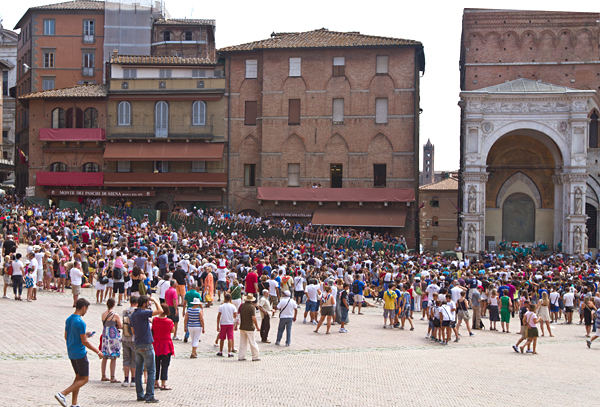
The Campo Filling Up Before The Drawing Of The Horses or La Tratta
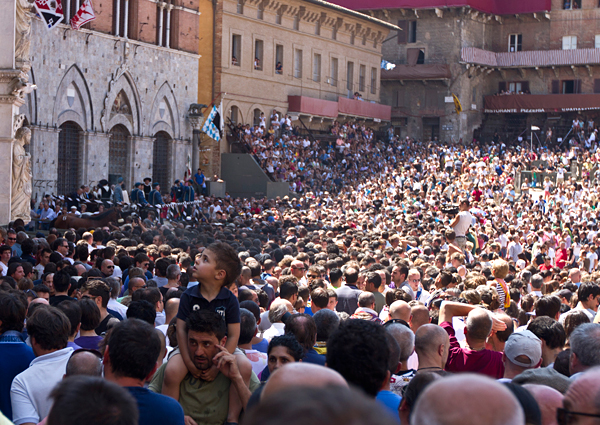
A Packed Campo Just Waiting For The Drawing To Begin. Nerves Were Taught & Excitement Was In The Air!
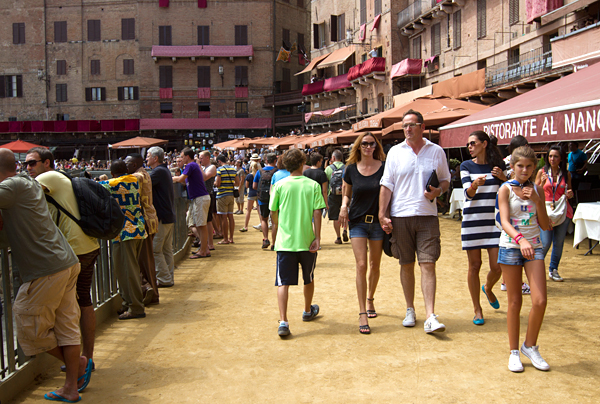
The Dirt Track The Horses Run On For The Palio. Folks Were Allowed To Walk On It Right Up To Race Time.

After Each Contrada Was Given Their Horse, The Trainer Led It Immediately Out Of The Campo Followed By the Members Of The Contrada.
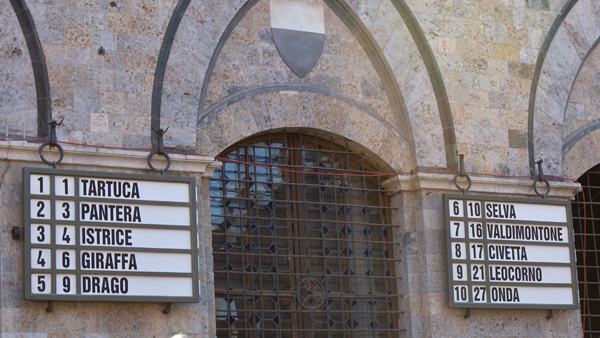
The Horses Are Chosen!
Deborah Mele
September 2012
So enjoyed this blog! I had the pleasure of being in Siena on my 50th birthday this past year. While there, Dario gave our conference group a tour of his contrada, which hosted us to a magnificent meal. My heart aches whenever I see photos of Siena–indeed any place in Italy. I was there for only a short time, but the experience is one that remains with me.
Absolutely fascinating! Would love to see the horses being brought inside the chapels for blessings.
I’ve been to two Palios with Dario. They were experiences of a lifetime! Dario took us to all the important events, the trials, the Brucco dinner, the Palio itself, and through the countryside. We learned so much and had a fabulous time! He also provides a great tour of Villa Dievole winery! And his books are great and very well written. I just finished his most recent one about the boar hunters of Chianti.
We just bought the book about wild boar hunting as well. I hope to start reading it soon.